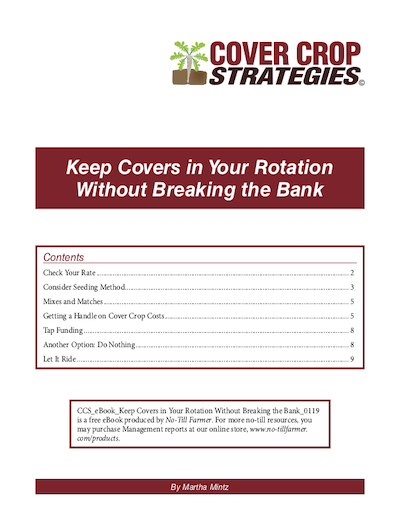Now is the time to improve and evolve your system.

Get a handle on your cover crop costs!
Corn prices are down at the current time, which forces farmers to find ways to decrease input costs. Though cover crops are important and vital for the protection and improvement of soil, they also seem to get caught in the crosshairs of money-saving strategies.
Experts say some farmers have been overdoing the seeding rates for cover crops, spending entirely too much money without much of an outcome.
So, what’s the perfect balance?
How does a farmer gauge whether or not enough seeds are being planted?
What is the minimum amount of seeding needed so costs can be reduced?
Reconsider Your Seeding Method: Is It Right For You?
How you seed your cover crops can greatly impact the rate that is needed to maintain them. The expense of equipment itself also greatly affects the rate, as any extra expense of a custom application can be detrimental to your pocketbook.
The burden of a job being done on another person’s schedule can take away from time that you could have spent out in the field.
In this report, learn how to think critically in regards to your seeding method. Aerial seeding and broadcasting may seem like the right move, but is it the best option for you? Or is drilling the best method?
Diversity Among Us: Mix & Matches
Diverse mixes of seed don’t have to carry an outstanding price tag. All it takes is the knowledge to determine the best amount of cover crop seed and the mix that helps your fields flourish.
The benefits of plant diversity are clear, but how much mixing is another issue.
This insightful cover-crop explores the many avenues successful farmers are using to determine the mix that is just right for them. There are many methods (online cover crop calculators, selecting cover crops with similarly sized seeds, etc.) of finding the perfect balance, all of which is available to you in this free eGuide.
Make Someone Else Pay For The Investment
Though the cost of seeding cover crops might be a burden, there are opportunities out there for you to find help elsewhere. Cost shares can help offset seed and planting costs, while farmers still gain the benefits. This could include any additional data that is collected off of those acres of land.
For example, in 2015 the Clean Water Indiana grant program allotted $72,500 to cost share cover crop programs. The states of Maryland and Iowa have also been known to provide cost-share funds for trying out cover crops. There IS money out there for you. Understandably, you might not know the best way of going about retrieving that money.
This should be no cause for concern though, as the “Tap Funding” segment of this report highlights these credible resources and what they can do to help cover your cover crop costs:
- Environmental Quality Incentives Program (EQIP)
- Conservation Stewardship Program
- Maryland Agricultural Water Quality Cost-Share Program
- Chesapeake Bay Restoration Fund
Are you ready to cut down the cost of your cover crops?
Are you ready to reduce expenses and boost revenues?
Yours for better cover cropping,
Cover Crop Strategies * No-Till Farmer * Conservation Tillage Guide * No-Till Insider
What new insights did you gain from this report? What jumped out at you?
Share your observations below.



Post a comment
Report Abusive Comment